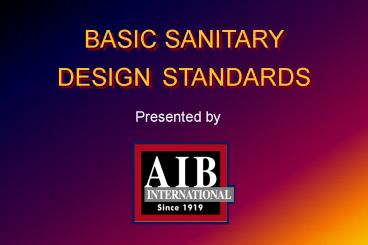Basic Sanitary Design Standards - PowerPoint PPT Presentation
1 / 23
Title:
Basic Sanitary Design Standards
Description:
Enhance the functionality of the system and not inhibit it. ... Selection of Fabrication Material. for Equipment ... to do- we are a new plant. Common Mistakes ... – PowerPoint PPT presentation
Number of Views:277
Avg rating:3.0/5.0
Title: Basic Sanitary Design Standards
1
BASIC SANITARY DESIGN STANDARDS
Presented by
2
Sanitation Standard should
- Enhance the functionality of the system and not
inhibit it. - Improve your ability to reduce risks of product
safety concerns. - Reduce time required to properly clean the unit.
3
Selection of Fabrication Material for Equipment
- Materials selected must be compatible with the
foods produced. If not, the following issues
could result - Odor
- Taste
- Color
- Direct contamination from the breakdown of the
materials - Unwanted reactions when using
- Cleaning chemicals
- Sanitizing solutions
- Pesticides
4
Considerations for Other Construction Materials
- Wire Commonly used in sifter, scalper, and
strainers. Should be made with materials with
magnetic capabilities to enhance their detection
in metal detectors and magnets. Series 400
stainless has magnetic properties. - Wood Not an acceptable material for food
processing equipment. Wood absorbs liquid,
produces odor, is porous, and cracks.
5
Considerations for Other Construction Materials
- Glass One of the most feared materials as a
food contaminant. Glass is difficult to detect
in food and poses a serious health threat if
ingested. Protect all essential glass and
replace all nonessential glass with polycarbonate
plastic materials.
6
Considerations for Other Construction Materials
- Plastic Have a variety of applications in the
food industry. Most are nontoxic and meet
regulatory requirements.
7
Considerations for Other Construction Materials
- Fiberglass Like plastics, there are
applications in the food industry. They perform
well in corrosive environments and are often used
in tank fabrication for corrosive materials. A
caution would be that they do produce toxic fumes
when burned. - Rubber Only rubber and synthetic materials
approved for food-contact should be used.
8
Considerations for Other Construction Materials
- Cloth Fabrics Applications exist for cotton,
wool, nylon, and other synthetic clothes. - Caulking Compounds vs. sealantsThere are many
and varied caulking compounds acrylics, butyl,
latex, and silicone. These materials should have
limited applications in a food plant. Use of
these products in a product zone should be
discouraged.
9
Considerations for Other Construction Materials
- Paint All paints used in the food plant
environment should be food-grade approved. Many
epoxy paints do meet this requirement.
10
Common Misconceptions
- Need a lot of money
- Stainless Steel always means sanitary design
- There is nothing we can do- we are an old plant
- There is nothing we need to do- we are a new
plant
11
Common Mistakes
- Design standard does not enhance, only inhibits
- Design standard increases time/labor for cleaning
- Selecting materials not compatible with food
12
Biggest Mistake
- Failing to train our people.All our people!
13
(No Transcript)
14
(No Transcript)
15
(No Transcript)
16
(No Transcript)
17
Good Design Considerations
18
(No Transcript)
19
(No Transcript)
20
(No Transcript)
21
(No Transcript)
22
RememberSanitation Standard should
- Enhance the functionality of the system and not
inhibit it. - Improve your ability to reduce risks of product
safety concerns. - Reduce time required to properly clean the unit.
23
Contact AIB International
- www.aibonline.org
- Judi Lazaro
- 800 633 5137 x254































